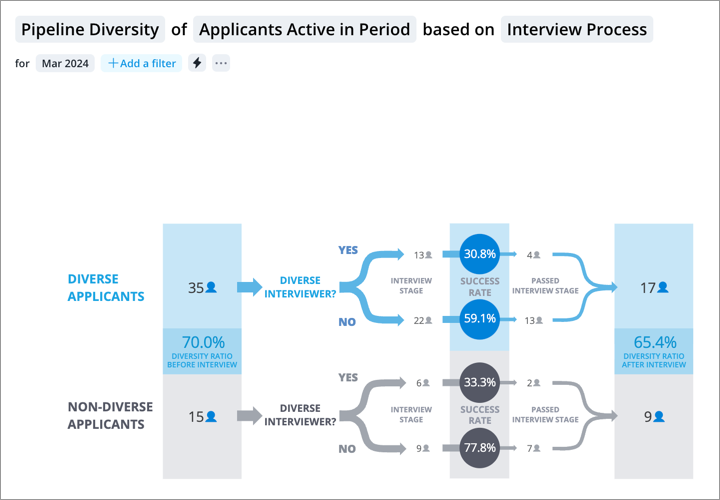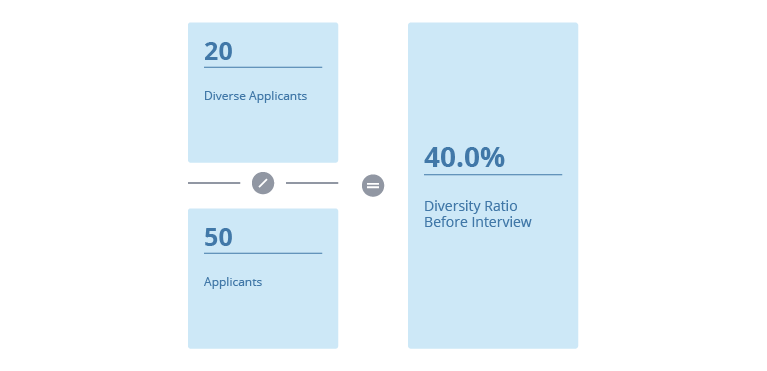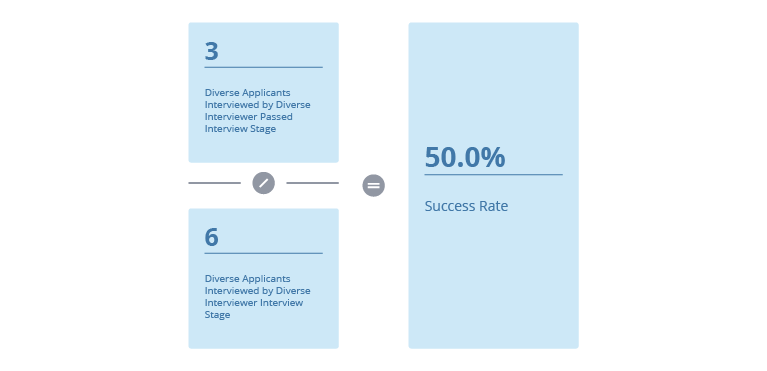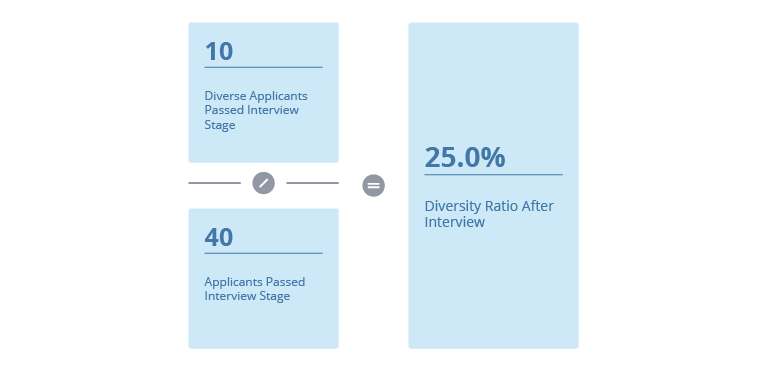Pipeline Diversity Visual
Compare the diversity of applicants before and after the interview stage.
The Pipeline Diversity visual looks at the outcomes of all applicants who completed the interview stage during the period to compare the success rates of diverse and non-diverse applicants. The visual also answers how successful the diverse and non-diverse applicants are when they're interviewed by a diverse interviewer. Look at the applicant counts on the left and right side of the visual to determine how many diverse applicants successfully reached the next stage or success stage of the Interview Process after the interview. Analyze the differences in the success rates to determine whether there is an issue with the interview process. For more information, see How we determine if the applicant was interviewed by a diverse interviewer.

How to explore the visual to gain insight
On the left side of the visual, you'll find the starting applicant count of diverse and non-diverse applicants before the interview. The Diversity Ratio Before the Interview is calculated by dividing the starting applicant count of diverse applicants before the interview by the total number of applicants.
For example, if there were 20 diverse applicants out of 50 applicants, the Diversity Ratio Before Interview is calculated as follows:

Note: The starting applicant count does not include all applicants who are at the interview stage during the period. For more information, see How the starting applicant counts are determined.
The applicants are further broken down into groups based on whether they were interviewed by a diverse interviewer. This is represented by the interview stage applicant counts displayed at the end of the diverging arrows. The visual then shows the number of applicants who moved passed the interview stage with a successful outcome for each group. This is represented by the passed interview stage applicant counts displayed before the converging arrows. The Success Rate for each group is calculated by dividing the passed interview stage applicant count by the interview stage applicant count.
For example, let's say 6 of the 20 diverse applicants were interviewed by a diverse interviewer. 3 out of the 6 applicants passed the interview stage with a successful outcome.
The Success Rate for diverse applicants interviewed by a diverse interviewer is calculated as follows:

Note: A successful outcome means the applicant reached the next stage or the success stage of the Interview Process after the interview.
On the right side of the visual, you'll find the successful applicant count of diverse and non-diverse applicants who moved passed the interview stage. The Diversity Ratio After the Interview is calculated by dividing the successful applicant count of diverse applicants by the total number of successful applicants.
For example, let's say 40 applicants passed the interview stage with a successful outcome with the following breakdown:
-
3 diverse applicants that were interviewed by a diverse interviewer passed the interview stage with a successful outcome.
-
7 diverse applicants that were interviewed by a non-diverse interviewer passed the interview stage with a successful outcome.
-
12 non-diverse applicants that were interviewed by a diverse interviewer passed the interview stage with a successful outcome.
-
18 non-diverse applicants that were interviewed by a non-diverse interviewer passed the interview stage with a successful outcome.
The Diversity Ratio After the Interview is calculated as follows:

Calculation details
How the starting applicant counts are determined
The visual looks at applicants that were at the interview stage and transitioned out of the stage during the period. An applicant is counted as having passed the interview stage when they reach the next stage, the success stage, or the rejected stage of the Interview Process during the period. These applicants are then categorized as a diverse or non-diverse applicant using the Minority concept. The starting applicant counts for diverse and non-diverse applicants are found on the left side of the visual.
If the visual accounted for all the active applicants in the pipeline at the interview stage during the period, you would see very low success rates because any applicant that remained at the interview stage at the end of the period would be counted as having a failed outcome.
How we determine if the applicant was interviewed by a diverse interviewer
To determine if the applicant was interviewed by a diverse interviewer, we look at the Interviewed by Minority property for the applicant. If the applicant was interviewed by a minority interviewer at the end of the period, then they are counted as having been interviewed by a diverse interviewer. This means if an applicant was interviewed multiple times during the period, the last interview in the period will be used to determine if the applicant was interviewed by a diverse interviewer.
